How To Successfully Introduce Yourself To A Top-tier Media Outlet
4 Proven Ways To Pitch Top-tier Media Outlets (Forbes and The Like)
Table of Contents
What Is Top-Tier Media? Why Is Getting Featured There So Important?
4 Proven Ways To Pitch Top-tier Media Outlets
1. Turn Trending News Into Irresistible Content
3. Turn Stories Into Value The World Needs
4. Collect Data And Produce Research-driven Content
3 Highly Successful Media Pitch Examples To Help You Stand Out
Example #1: Pitch Your Data The Right Way
Example #2: Add My Tool To Your Current Post
Example #3: Thank People And Invest In Building Lasting Relationships
How to Hire The Best PR Firm For Your Business (My Two Honest Cents)
What Is Top-Tier Media? Why Is Getting Featured There So Important?
You’re already familiar with these terms:
- Local outlets
- Regional outlets
- Magazines
The difference between these three is that they’re each a separate piece of your PR strategy. If you want to get more exposure in your local area, it’s best to go after local outlets. If you want to hit more people in your country, target regional outlets.
Then there’s top-tier media. They’re the largest publications. Think The New York Times, USA Today, Wall Street Journal and others in the top echelon of magazines.

Regardless of your specific PR goals, top-tier media is REALLY important in opening more doors for your business.
Honestly, just getting your name on an outlet like Inc. means getting noticed, and it means you can land even more spots on other, equally influential outlets.
However, getting past the lobby with top-tier media is hard. And we know this first-hand because we’ve helped a dozen entrepreneurs like yourself to get featured on their favorite outlets.
Now, let’s show you how to get there.
4 Proven Ways To Pitch Top-tier Media Outlets
Finding great content ideas that journalists love and can’t resist sharing is painfully difficult.
It’s not your fault. You’re not a writer.
As a PR strategist and consultant, I know what journalists think are great content ideas, and I’ll share four proven approaches to borrow for your next cold pitching campaign.
1. Turn Trending News Into Irresistible Content
Trending news topics aren’t a new thing. But they’re still at the top of journalists’ most-wanted lists.
There are multiple ways to find trending news. For example, you can put a keyword or topic into Google Trends and see the how popular it is:
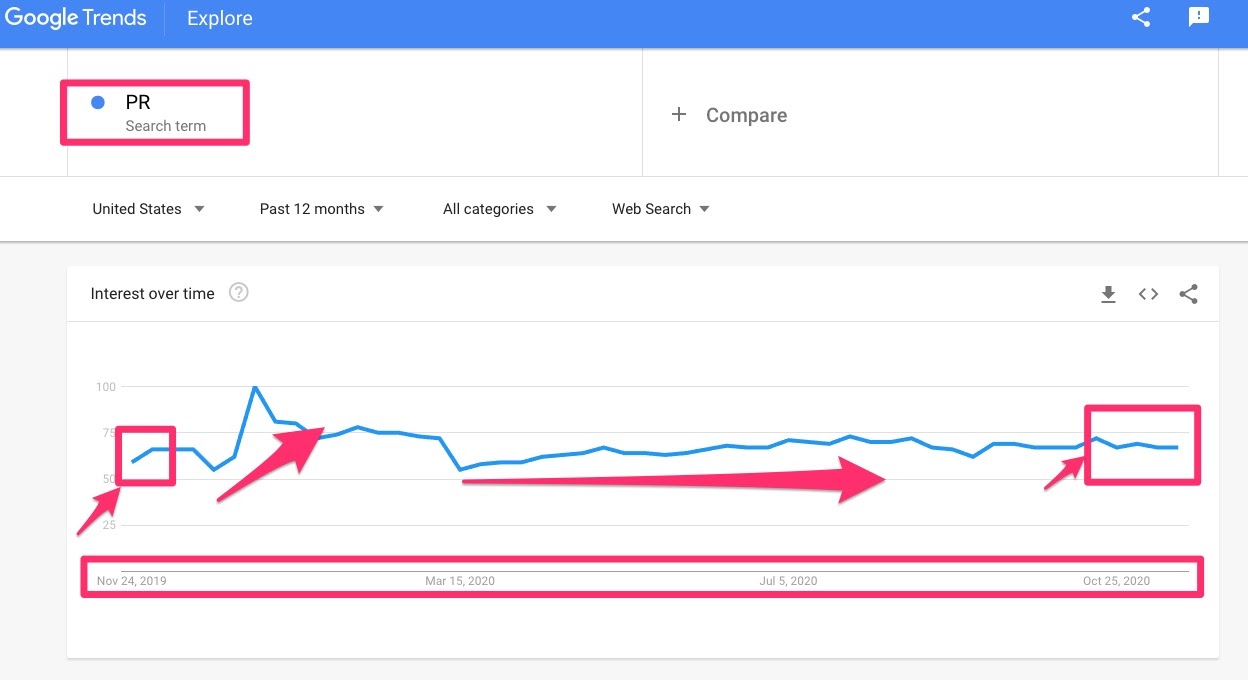

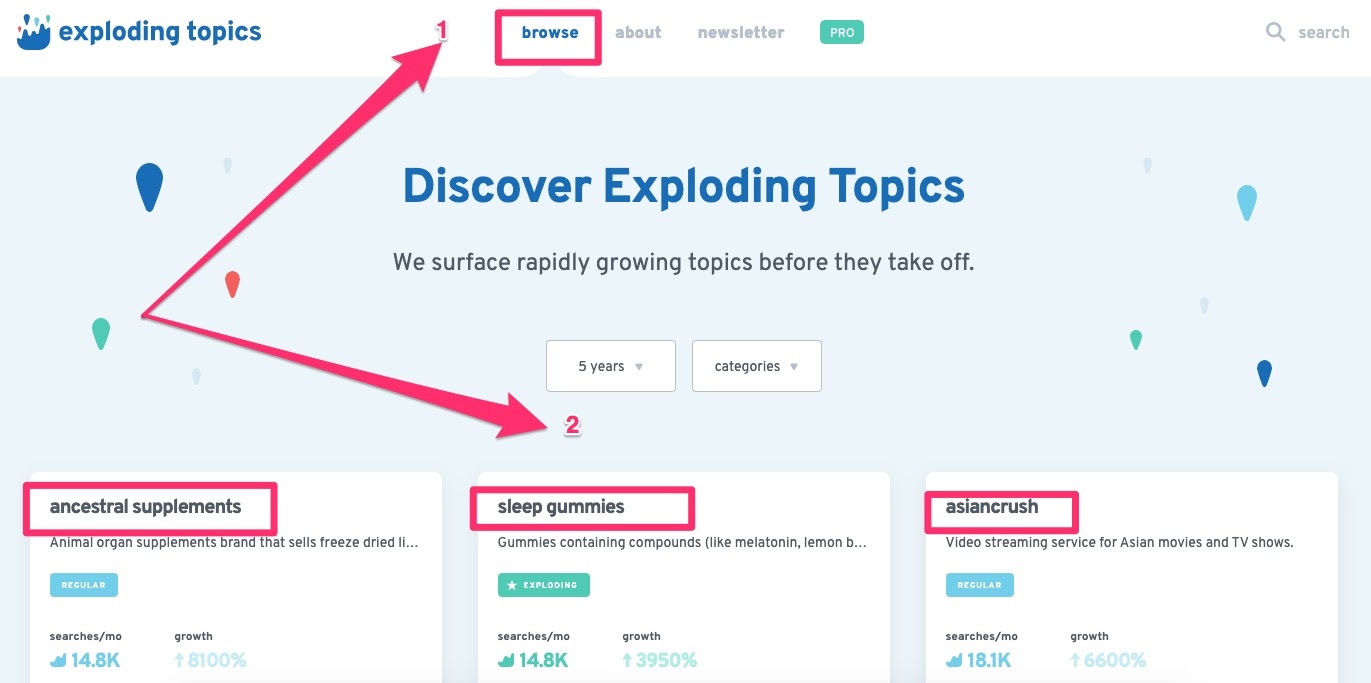
The tool also has a search option to see if the topic you have in mind is trendy. Not only that, you can subscribe to their email list and get weekly mailshots full of ideas that you can keep for future use.
Now, after you’ve found your trending topic. You can use it by:
- Relating to the trend with a personal story,
- Producing unique research, or
- Writing a different opinion on the trend.
Not a big fan of trends? Become an idea hunter instead.
2. Nationalize A Local Story
As a successful entrepreneur, you probably subscribe to at least one local newspaper, and most importantly, you read the news every single day – or weekly, at least.
Now build a new habit: hunt for ideas. The articles you read in your local news may have a national or even international relevance.
Scan the stories and look for patterns. Can you imitate one or more, with a slightly different flavor?
For example: “A day in the life of…”. You can relate to these local stories. They mostly use the behind-the-scenes angle. But they can be powerful if they’re done right.
You’re talking to humans like yourself and everyone would love to hear an honest, relevant opinion on a shitty day, a great achievement, or something else that resonates. You get the picture.
The next time you read a newspaper, have your lucky pen and notebook alongside. Note all the ideas and angles you can think of, then use a tool like Buzzsumo.com to see if they make a good topic idea.

The best thing about Buzzsumo is that if the keyword or phrase you test doesn’t get much traction, you’ll find similar phrases that people crave. Use them!
3. Turn Stories Into Value The World Needs
We are human. We love stories. Our brains grasp stories quicker than any other form of content.
But to create a story that people will be excited to read, you need to have something extraordinary to share.
One of the greatest examples of turning a story into value the world craves is the story of Buffer’s founder:
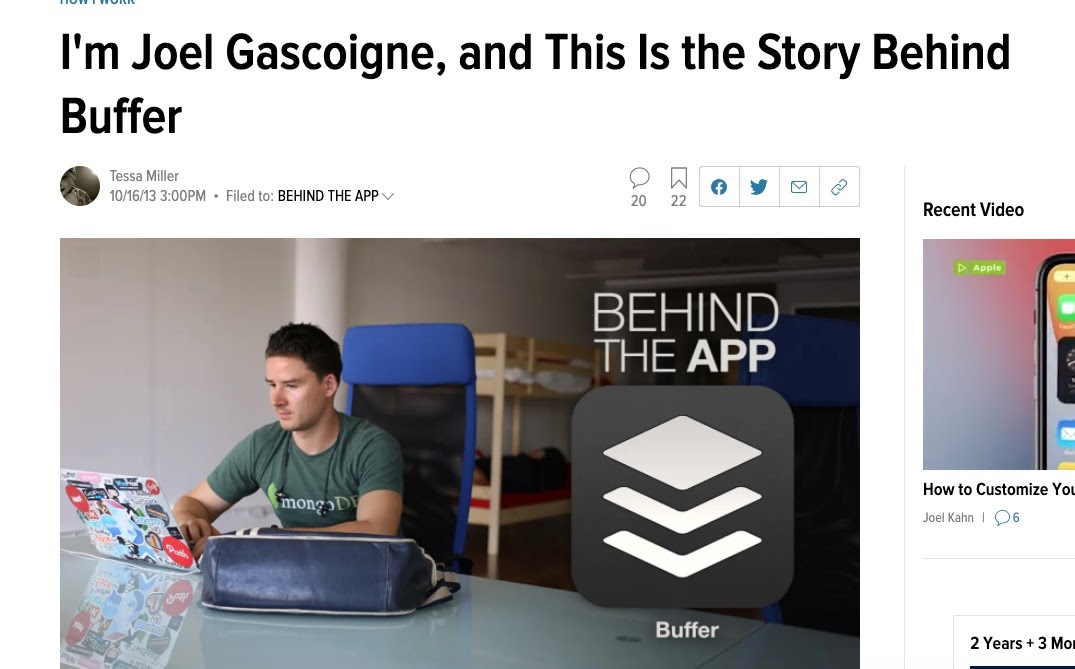
These stories attract journalists. They look for this kind of content every day.
To create such a story; follow this simple framework:
- Introduce your problem. What made you start your company in the first place?
- Show how you solved that problem – your unique capability to solve things.
- Share how helping your clients impacted your business. What success has this produced?
Although this may be a simple framework, it’ll help you produce kickass stories that motivate, teach, and show people how to improve their own businesses and lives.
Sit down with your team and ask them, “How can we share a unique story about our brand?“
As long as you’re a successful business owner, you’ve overcome countless hurdles. There are entrepreneurs on the other side of those obstacles who are still stuck. Help them.
Great stories can go viral, which will translate into more links and shares. That means more exposure for your business for FREE.
4. Collect Data And Produce Research-driven Content
How can you get noticed by journalists ASAP?
Produce exclusive research.
Don’t take my word for it. A recent study done by Buzzsumo and Mantis Research found that most companies that produced original research saw a huge impact on their business:

But how does original research help you get noticed by top-tier media?
Here’s how: It makes pitching so much easier.
Every journalist, reporter, and blogger is looking for fresh data to back up and support their claims, statements, and ideas. If you can help them with that, they’ll be more than happy to link to your website.
There are countless ways to collect data and produce original research. Here’s a few to get you started:
1. Look for patterns and analyze the data. For example, this original research by OrbitMedia on web design standards.
How did they do it?
They wanted to know if a search box on a website is important. They headed to Alexa.com, picked a list of 50 websites, had a few freelancers review the list, then turned their findings into a solid blog post.
This is a screenshot from their blog:

Look for patterns and analyze the data. For example, this original research by OrbitMedia on web design standards.
How did they do it?
They wanted to know if a search box on a website is important. They headed to Alexa.com, picked a list of 50 websites, had a few freelancers review the list, then turned their findings into a solid blog post.
This is a screenshot from their blog:
Most bloggers will use it and link to it, since it backs up many claims they can make about the most popular, effective, or powerful use of website real estate.
The results? OrbitMedia secured more than 175 backlinks and over 600 shares.
2. Share your experiments. Sometimes what gets accomplished in-house should be shared publicly.
For example, this article by Copyhackers nailed it. They shared how they tested the Mad Mimi pricing page.
How did they do it?
The team at Copyhackers wanted to measure the results of their copywriting work. So they A/B tested a pricing page to see how the conversions would differ. And they found a 500% increase in conversions.
Here’s a screenshot from their article:

The results? They had more than 25 links and over 120 social media shares.
3. Survey your industry. This is a classic approach but it still gets results.
For example, this piece on whether bad breath is a game-breaker when dating nailed it:

How did they do it?
Instead of how they did it, let’s see how you can do it. For this type of content to be successful, you have to collect at least 500 responses, for accuracy.
You have to prepare a topic that people frequently talk about. Think PR for small businesses in our case, sales for SaaS if you’re a SaaS consultant, and so on.
Then set up at least five questions.
Then use a mix of ads and outreach to get the right participants to fill out the survey.
The expected results?
A ton of links and social media shares.
In every industry, there’s a GAP. Be the first to find that gap and analyze it, using one of the above methods to tackle it.
It’s hard to produce original research, but as you can see it’s totally worth it.
Now, you’ve probably found a few topics ideas to pitch. The next step is the pitch itself…
3 Highly Successful Media Pitch Examples To Help You Stand Out
A media pitch is simply your ask to get a backlink, a mention, or a feature through a cold email contact.
But not all pitches are equal. You have to stand out.
Otherwise, you’ll hear crickets.
Note: We’ve written a detailed section on pitching as part of our “get featured on Forbes” article. You can read how to write a killer cold pitch email here.
We’ve hand-picked some of the best media pitch examples to inspire you.
Example #1: Pitch Your Data The Right Way
A new study by Factl says that over 1,200 top-tier media publishers get a TON of irrelevant pitches. Only 1% of pitches are completely valuable.

That’s a shocking statistic.
But it leads perfectly to our example. If you want to stand out and get noticed you have to share something worthy. And there’s nothing better than fresh data.
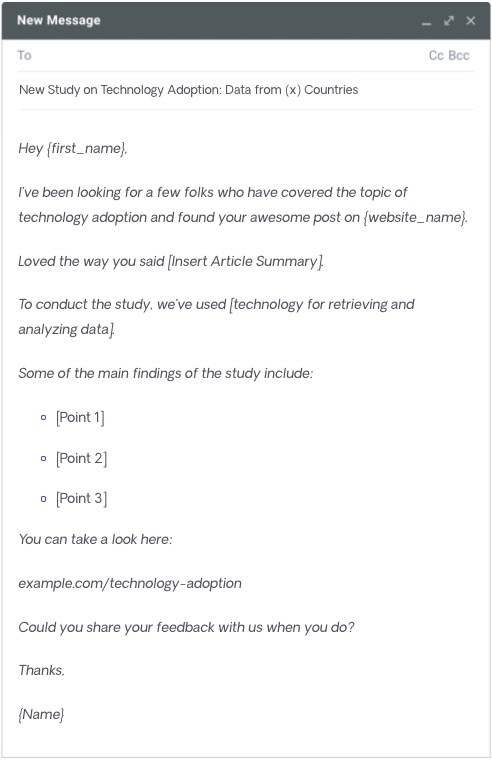
Why is it good? It’s a valuable email. Remember journalists and bloggers are wordsmiths. Anything that can help them beat writer’s block is priceless, so you can imagine what a boon fresh data is for them.
What to learn from it:
- Be relevant. If you conducted original research on why SaaS SEO is a great strategy and shared it with the politics department at your targeted outlets, you won’t get a single response. Pick the right people to pitch.
- Personalize your email. Showing that you’ve done your groundwork goes a long way.
- Explain why you think your piece is good data.
- Give them a grasp of your findings.
Paste the study’s URL directly. - Have a clear ask at the end of your email. In our case, asking for their feedback.
Generally, this is a SOLID email. Steal the angle, not the exact words! 😉
Example #2: Add My Tool To Your Current Post
If you’re a techy entrepreneur, you know the best tools in your industry. And you’re very familiar with listicles that cover exactly that subject, like this example on a top tier magazine for top marketing tools.
The approach here is to search using a mix of the following terms:
- Top
- Best
- Review
- Comparison
- List
- Software
Then add your company’s key solution right after one of the terms above:
- Top sales tracking software
- Best sales tracking tools
- Sales tracking tools review
- …etc.
Then you can reach out to the blogger or journalist who wrote each piece and ask them to add your tool, because it’s a really powerful addition to their list.
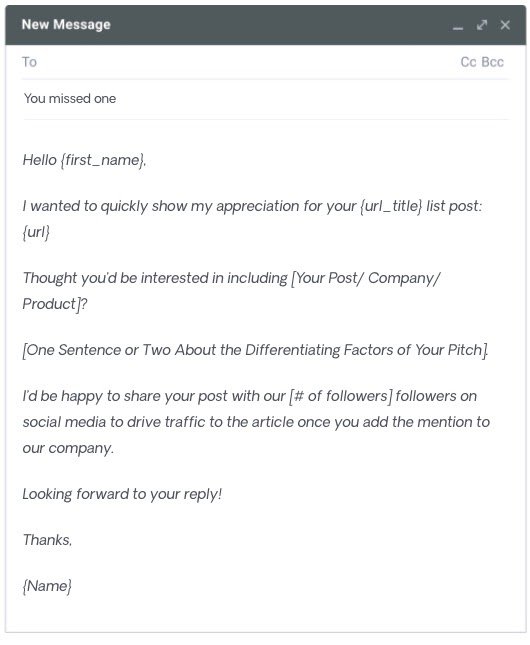
Why is it good? We’re humans and we forget things. Sending a note to the journalist to remind them about your tool can be a great help for them, and their readers.
What to learn from it:
- Personalization is key.
- Showing that you read the article you’re referring to makes your pitch stand out.
- Journalists love honest feedback; provide that.
- Explain clearly why they should list your tool.
- Be kind. Stating that you’ll post it on social media to your (ideally huge) following really makes their day.
If your product is better than the others in their list, speak up and show it. But make it worth their while, by sharing the article to your active followers or offering a mention in your next newsletter.
Example #3: Thank People And Invest In Building Lasting Relationships
Honestly, how much impact would an email from a stranger have, if it said that your article was essential in helping them achieve a critical milestone in their personal life or their career?
Huge, right?
We all want to feel special.
Instead of pitching directly, read a few articles from the top journalists in your industry. Apply their tips and send them a thank-you email
They’ll love it and probably reply.
And that’s why this example is a steal:
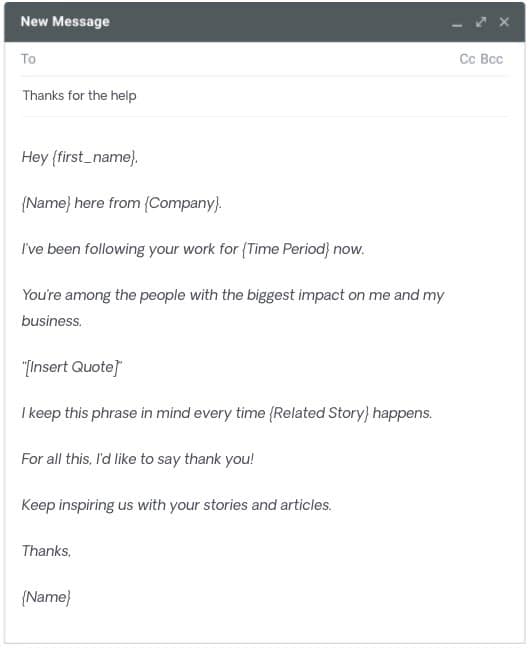
Why is it good? It showcases that you take action. And people love seeing that their advice has helped someone.
What to learn from it:
- Again personalize, personalize, and personalize more.
- Be real. People can smell spammy emails a mile away. Show what article or piece of content you liked.
- Describe clearly what you liked the most about it, what you took from it, and how you applied it.
- Thank them, and wish them the best of luck. (I know I sound like your mom, but this is crucial).
It means the world to everyone to receive honest emails from their followers. Don’t fake it. And if you’ve been following a bunch of journalists or bloggers and have used their advice and tips, let them know.
How to Hire The Best PR Firm For Your Business (My Two Honest Cents)
By following the steps above, you can run your first PR campaign. We’ve distilled everything you need to succeed.
I’d love to hear more about your success following our framework: tweet at me.
So what’s the real question now?
Is it better to do it yourself or to hire a PR firm?
Our friends at Respona.com have answered this question beautifully:

If you have the budget and would rather focus more on other areas of your business that you enjoy the most, you should probably hire a PR firm.
I might be biased, of course. But it seems clear to me that having multiple skilled people run entire public relations campaigns on your behalf means more exposure and eyeballs on your content, which drive more leads and sales.
However, you should consider a few key things before making the move:
- Know your goal. What image of your business do you want people to have? What are the outlets you’re primarily focused on getting featured by? How will this impact your business? Be specific, and set the right goals for your business.
- Find your angle. People don’t want to read the same old content, or hear the same stories over and over again. You must REALLY have a unique business that’s well-structured, well-oiled, and is totally crushing it. This way, you can ensure that your target customer will be interested in doing business with you, and as a result, your PR campaign is a success.
- Have a budget in place. I’ve said this before but I’ll say it again. PR is not like throwing $100 at someone on Fiverr for a few articles. Before even considering a PR firm, you should know that it can cost you anything from $2,000 to $30,000 or more, depending on your goals, business size, and where you’re heading. Know your numbers.
- Be patient. To keep increasing your exposure and sales, give your PR people the time they need to launch a successful campaign.
- Be ready to fulfill the demand! Could your business manage a 1,000% increase in clients in the next three months? Seriously though, your service delivery system has to be as strong as your PR stories, otherwise you’ll fail miserably to respond to the demand that your PR firm generates for you.
This is a hard exercise. It’ll take time to gather all your information and tell if you can afford to hire a PR firm or whether you should do it yourself.
The good news? We have strong relationships with the leading top-tier media outlets. Forbes, Inc., Fast Company, and many more. Not just that, we publish monthly content on these outlets:
- 12,000+ articles on Forbes
- 9,000+ articles on Inc.
Our PR service is designed to help you achieve dream coverage. However, we are very exclusive. What you need to qualify for our service:
- You’re an entrepreneur.
- You run a 7-figure business (at least). You want us to target publications that will make you instantly recognisable and supercharge your reputation? You absolutely must have a very successful business.
- There’s something unique about you or your story. Readers are constantly bombarded with stay-at-home parents who’ve built successful businesses. We need something different that relates to your own unique problems and means you stand out.
If you’re serious about getting your name spreads like wildfire on your favorite outlets, click here and complete the form. I’ll be in touch with our next steps!
Final Thoughts
As you can see, introducing yourself successful to a top-tier media outlet is mainly a research effort. Don’t rely on assumptions. Instead:
- Find the right outlets that match your business niche.
- Take time to find really relevant topic ideas. Don’t rush it.
- Don’t copy-paste the templates on the internet. Study them and learn from them.
- If you have the budget, it’s probably the right time to hire a PR firm for your business.
Now that you’re here:
We help successful entrepreneurs like yourself get featured on their targeted publications. Let’s see if we’re a good fit.
Rhonda Swan
Rhonda Swan is an International Speaker, Best Selling Author, Personal Branding and Business Strategist. Rhonda is the CEO and Founder of the Unstoppable Branding Agency where she works alongside visionaries, experts, entrepreneurs, and businesses that go from being the world’s best known secret, to the world’s best-known expert with PR, Media and Expert Branding.

